Articles
- Page Path
- HOME > Epidemiol Health > Volume 41; 2019 > Article
-
Review
Meta-analysis of the prevalence of depression among breast cancer survivors in Iran: an urgent need for community supportive care programs -
Hassan Ahmadi Gharaei1
 , Mostafa Dianatinasab2
, Mostafa Dianatinasab2 , Seyyed Mostafa Kouhestani3
, Seyyed Mostafa Kouhestani3 , Mohammad Fararouei4
, Mohammad Fararouei4 , Hossein Moameri1
, Hossein Moameri1 , Reza Pakzad5,6
, Reza Pakzad5,6 , Reza Ghaiasvand7
, Reza Ghaiasvand7
-
Epidemiol Health 2019;41:e2019030.
DOI: https://doi.org/10.4178/epih.e2019030
Published online: July 4, 2019
1Department of Epidemiology, Faculty of Public Health, Tehran University of Medical Sciences, Tehran, Iran
2Department of Epidemiology, Center for Health Related Social and Behavioral Sciences Research, Shahroud University of Medical Sciences, Shahroud, Iran
3Department of Health Management and Economics, School of Public Health, Tehran University of Medical Sciences, Tehran, Iran
4Department of Epidemiology, Faculty of Public Health, Shiraz University of Medical Sciences, Shiraz, Iran
5Noor Research Center for Ophthalmic Epidemiology, Noor Eye Hospital, Tehran, Iran
6Faculty of Health, Ilam University of Medical Sciences, Ilam, Iran
7Oslo Centre for Biostatistics and Epidemiology, Department of Biostatistics, Institute of Basic Medical Sciences, University of Oslo, Oslo, Norway
- Correspondence: Mostafa Dianatinasab Department of Epidemiology, Center for Health Related Social and Behavioral Sciences Research, Shahroud University of Medical Sciences, Shahroud 3614773955, Iran E-mail: dianatinasab@sums.ac.ir
©2019, Korean Society of Epidemiology
This is an open-access article distributed under the terms of the Creative Commons Attribution License (http://creativecommons.org/licenses/by/4.0/), which permits unrestricted use, distribution, and reproduction in any medium, provided the original work is properly cited.
Figure & Data
References
Citations

- The prevalence of anxiety and depression in cancer around the world: An overview of systematic reviews evaluating 128 meta-analyses
Javier Martinez-Calderon, Cristina García-Muñoz, Alberto Marcos Heredia-Rizo, Francisco Javier Cano-García
Journal of Affective Disorders.2024; 351: 701. CrossRef - Global prevalence and factors associated with preoperative depression in women undergoing breast surgery: a meta-analysis and meta-regression
Celest Su Yi Leo, Ling Jie Cheng, Xin Rong Lam, Honggu He
Breast Cancer Research and Treatment.2024; 205(3): 425. CrossRef - Breast cancer survivors–supportive care needs: systematic review
Rahimeh Khajoei, Mahnaz Ilkhani, Payam Azadeh, Sima Zohari Anboohi, Fatemah Heshmati Nabavi
BMJ Supportive & Palliative Care.2023; 13(2): 143. CrossRef - How does social media use influence the mental health of pancreatic cancer patients: a chain mediating effect of online social support and psychological resilience
Yi Wang, Sheng Bao, Yubing Chen
Frontiers in Public Health.2023;[Epub] CrossRef - Prevalence and severity of anxiety and depression in Chinese patients with breast cancer: a systematic review and meta-analysis
Fuying Tao, Mengnan Xu, Qi Zou, Lin Tang, Jianping Feng, Zhenyu Li
Frontiers in Psychiatry.2023;[Epub] CrossRef - Effect of alcohol consumption on breast cancer: probabilistic bias analysis for adjustment of exposure misclassification bias and confounders
Reza Pakzad, Saharnaz Nedjat, Hamid Salehiniya, Nasrin Mansournia, Mahyar Etminan, Maryam Nazemipour, Iraj Pakzad, Mohammad Ali Mansournia
BMC Medical Research Methodology.2023;[Epub] CrossRef - Evaluation of anxiety and depressive symptoms in a sample of adult patients with cancer at Al-Furat Cancer Hospital/Najaf
Hussein Amer Hussein Al-Saffar, Nibras Alaa Hussain
Medical Journal of Babylon.2023; 20(4): 852. CrossRef - Global and regional geographical prevalence of depression in gastric cancer: a systematic review and meta-analysis
Mostafa Kouhestani, Hasan Ahmadi Gharaei, Mohammad Fararouei, Hasan Hosienpour Ghahremanloo, Reza Ghaiasvand, Mostafa Dianatinasab
BMJ Supportive & Palliative Care.2022; 12(e4): e526. CrossRef - The prevalence of anxiety and depression and its association with coping strategies, supportive care needs, and social support among women with breast cancer
Hassan Okati-Aliabad, Alireza Ansari-Moghadam, Mahdi Mohammadi, Shiva Kargar, Fariba Shahraki-Sanavi
Supportive Care in Cancer.2022; 30(1): 703. CrossRef - Association of Chinese herbal medicine use with the depression risk among the long-term breast cancer survivors: A longitudinal follow-up study
Shu-Yi Yang, Hanoch Livneh, Jing-Siang Jhang, Shu-Wen Yen, Hua-Lung Huang, Michael W. Y. Chan, Ming-Chi Lu, Chia-Chou Yeh, Chang-Kuo Wei, Tzung-Yi Tsai
Frontiers in Psychology.2022;[Epub] CrossRef - Effectiveness of Matrix Treatment on Depression and Temptation in Consumption in Amphetamine Dependent Individuals
Homayoun Farhad, Shahnam Abolghasemi, Tahereh Hamzehpoor
Iranian Evolutionary and Educational Psychology.2022; 4(4): 76. CrossRef - Feasibility of modified radical mastectomy with nipple-areola preservation combined with stage I prosthesis implantation using air cavity-free suspension hook in patients with breast cancer
Jiaqi Liu, Heshan Yu, Yuxiao He, Ting Yan, Yu Ding, Jun Chu, Ning Gao, Xiaona Lin, Yanbin Xu, Guijin He
World Journal of Surgical Oncology.2021;[Epub] CrossRef - Depression and Anxiety in Patients With Cancer: A Cross-Sectional Study
Abdallah Y. Naser, Anas Nawfal Hameed, Nour Mustafa, Hassan Alwafi, Eman Zmaily Dahmash, Hamad S. Alyami, Haya Khalil
Frontiers in Psychology.2021;[Epub] CrossRef - Body image, internalized stigma and enacted stigma predict psychological distress in women with breast cancer: A serial mediation model
Mohammadali Amini‐Tehrani, Hadi Zamanian, Mona Daryaafzoon, Seyedehroja Andikolaei, Mahshid Mohebbi, Arefeh Imani, Bita Tahmasbi, Sahar Foroozanfar, Zahra Jalali
Journal of Advanced Nursing.2021; 77(8): 3412. CrossRef - Posttreatment Anxiety, Depression, Sleep Disorders, and Associated Factors in Women Who Survive Breast Cancer
Penelope Aggeli, Georgia Fasoi, Afroditi Zartaloudi, Konstantinos Kontzoglou, Michael Kontos, Theocharis Konstantinidis, Ioannis Kalemikerakis, Ourania Govina
Asia-Pacific Journal of Oncology Nursing.2021; 8(2): 147. CrossRef - Prevalence of Severe Depression in Iranian Women with Breast Cancer: A Meta-Analysis
Parvaneh Isfahani, Marziye Arefy, Monire Shamsaii
Depression Research and Treatment.2020; 2020: 1. CrossRef - Factor structure and reliability of Persian version of hospital anxiety and depression scale in patients with breast cancer survivors
Karimollah Hajian-Tilaki, Erfaneh Hajian-Tilaki
Health and Quality of Life Outcomes.2020;[Epub] CrossRef - Patient‐centred communication for women with breast cancer: Relation to body image perception
Fariba Ghaffari, Akram Ghahramanian, Vahid Zamanzadeh, Tonia C. Onyeka, Arefeh Davoodi, Effat Mazaheri, Mohammad Asghari‐Jafarabadi
Journal of Clinical Nursing.2020; 29(23-24): 4674. CrossRef

 KSE
KSE
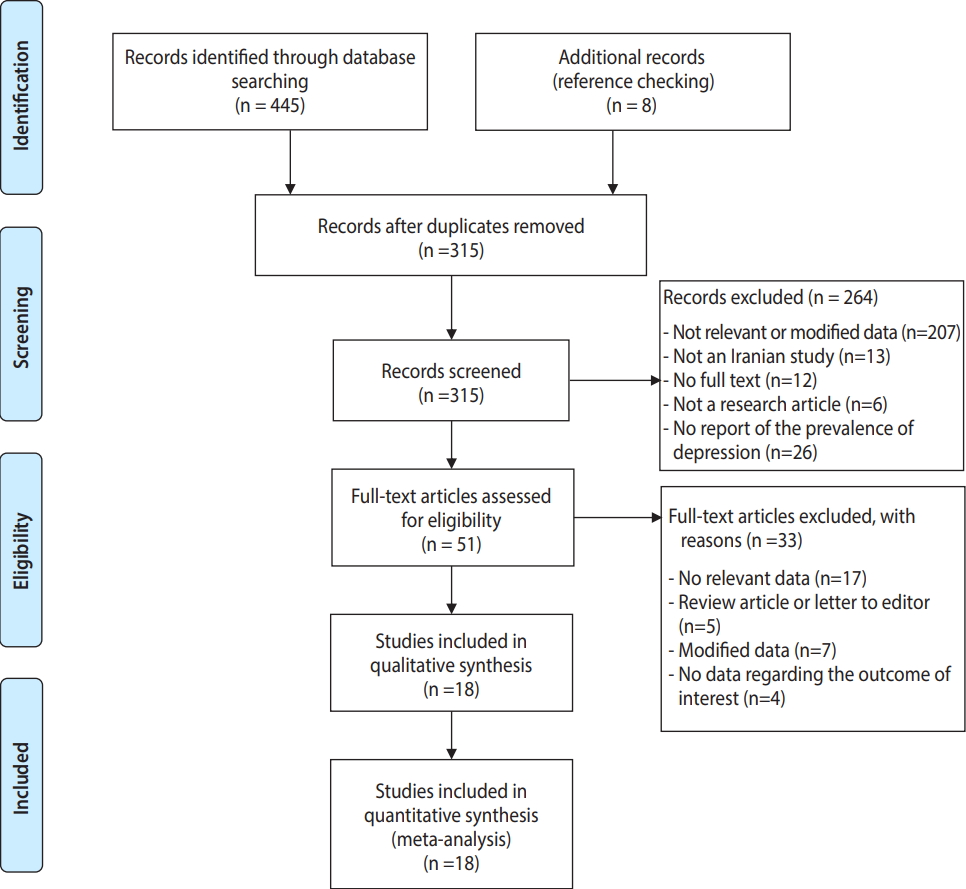
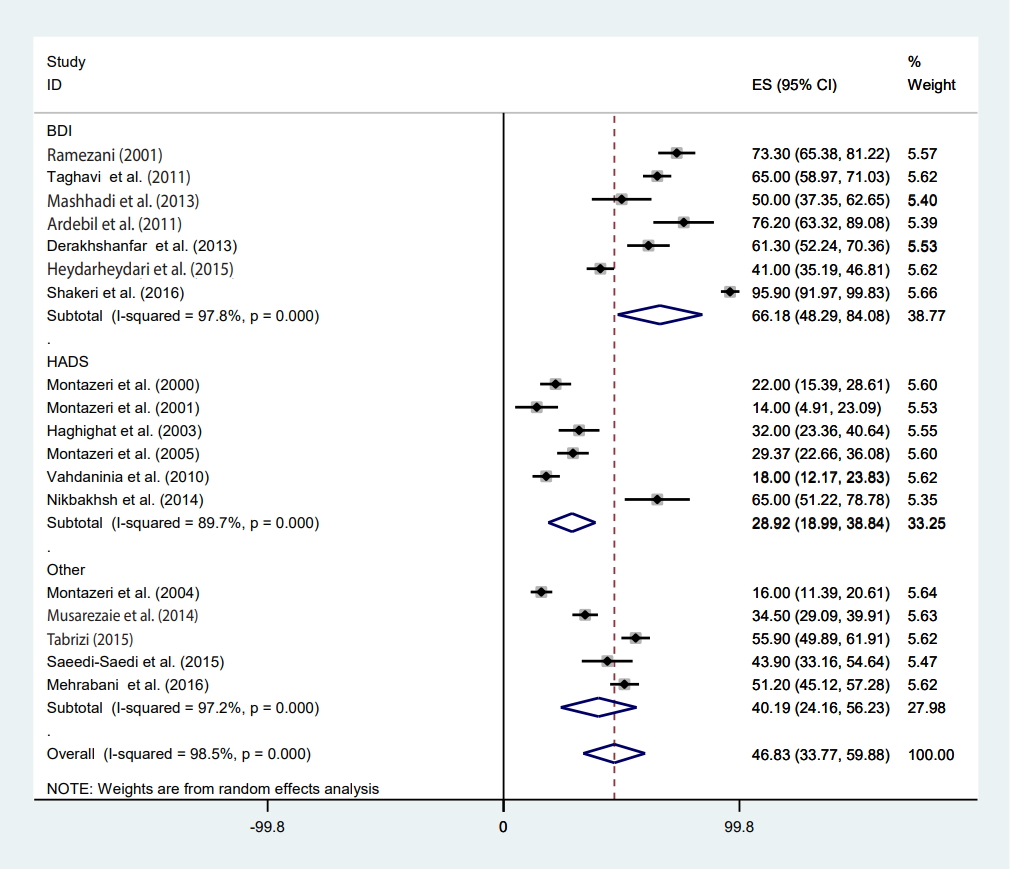
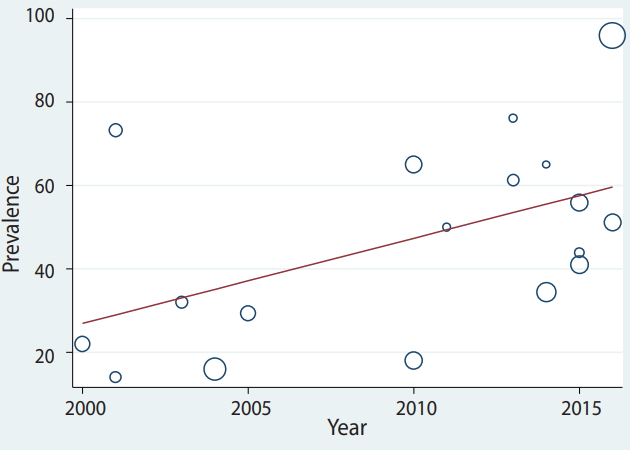
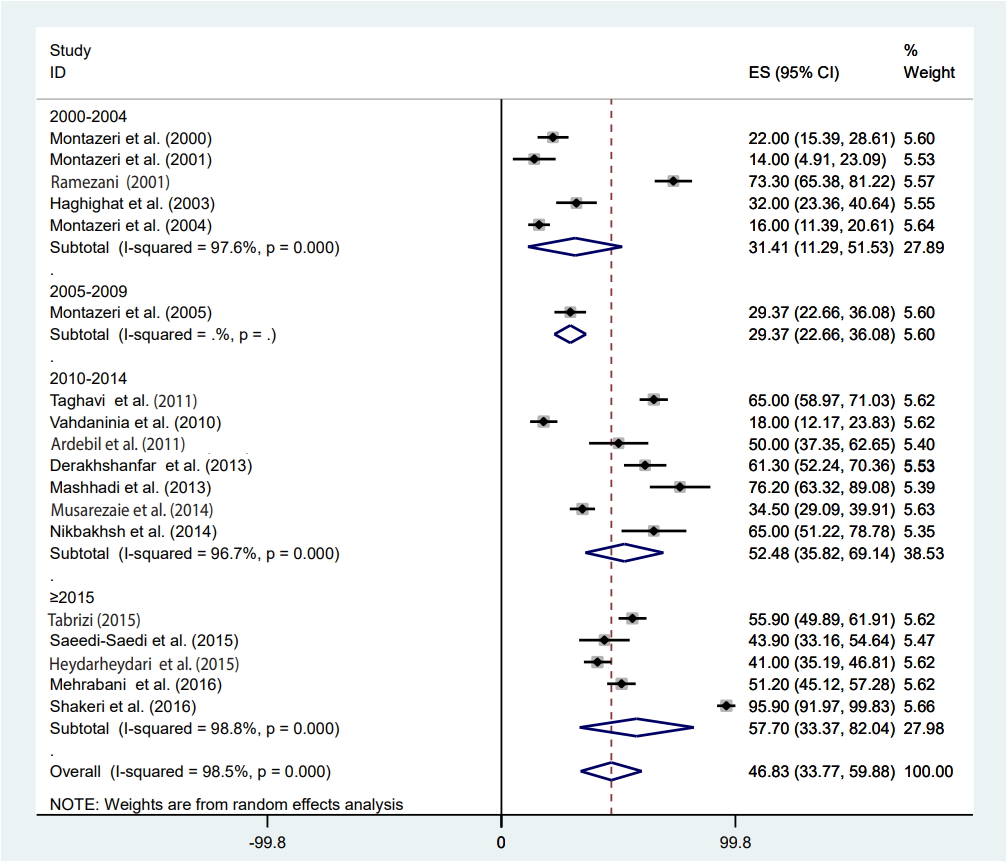

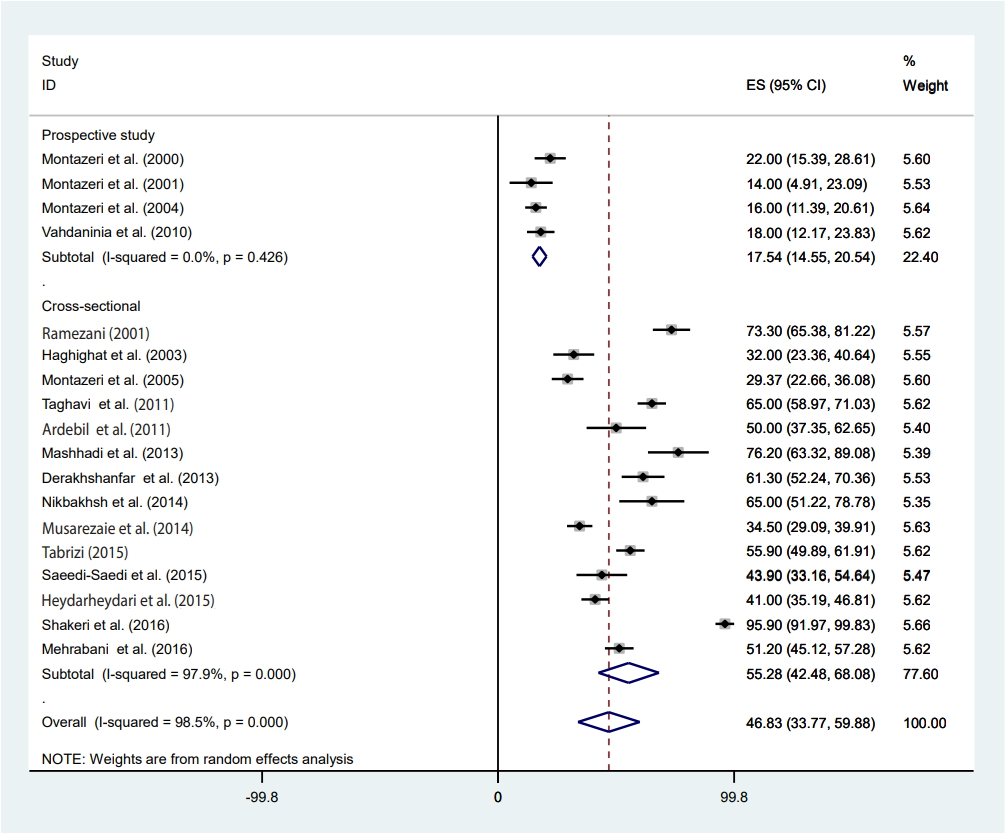
 PubReader
PubReader ePub Link
ePub Link Cite
Cite







